Assessing UK's Performance and Market Structure of Rolls-Royce
VerifiedAdded on 2023/01/16
|12
|3309
|69
AI Summary
This document analyzes the current performance of the UK economy in comparison to past years, assesses the market structure of the industry in which Rolls-Royce operates, and explores the prospects of the UK economy. It also evaluates the challenges faced by Rolls-Royce and provides recommendations for potential strategies. The subject is Business Economics.
Contribute Materials
Your contribution can guide someone’s learning journey. Share your
documents today.

BUSINESS ECONOMICS
Secure Best Marks with AI Grader
Need help grading? Try our AI Grader for instant feedback on your assignments.
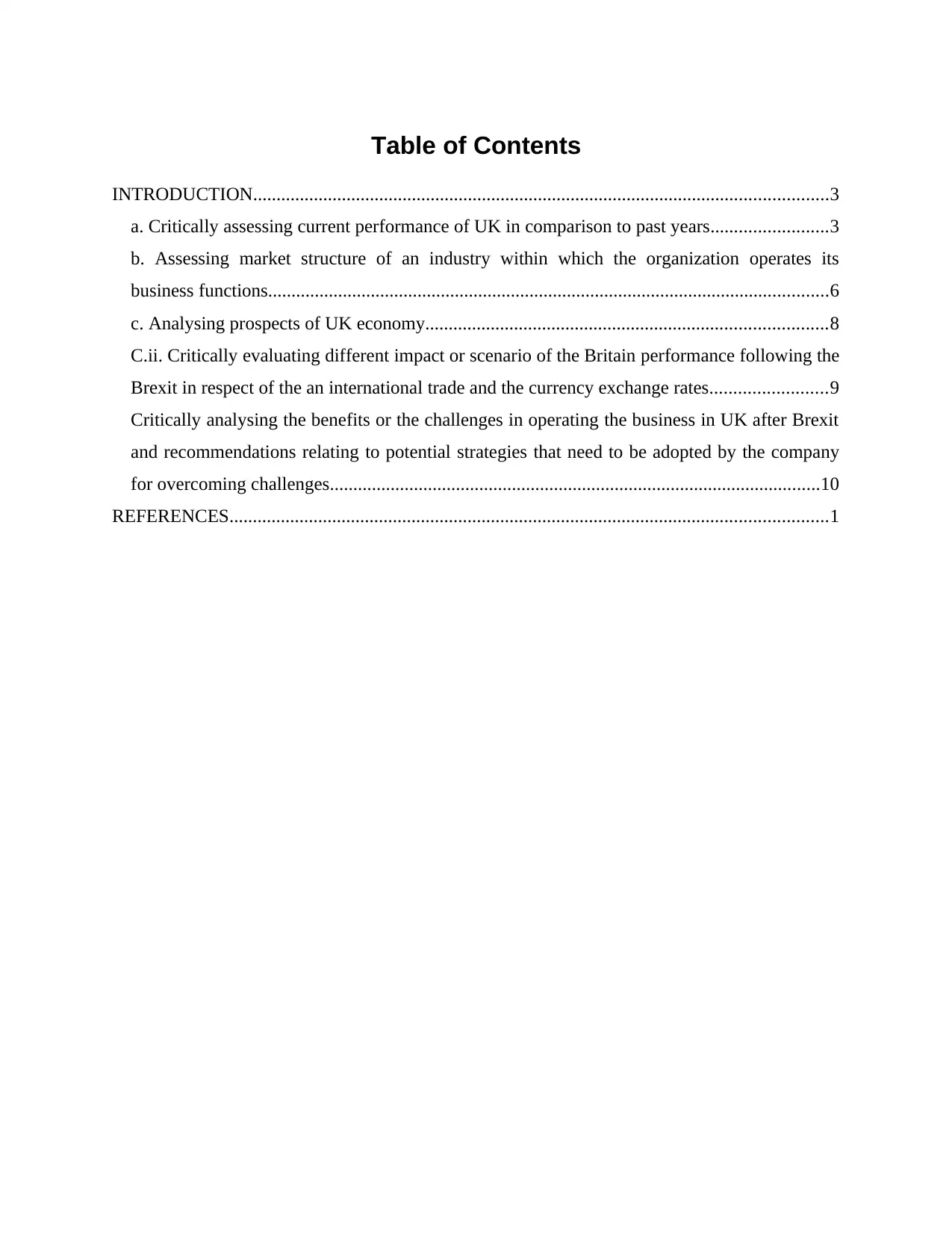
Table of Contents
INTRODUCTION...........................................................................................................................3
a. Critically assessing current performance of UK in comparison to past years.........................3
b. Assessing market structure of an industry within which the organization operates its
business functions........................................................................................................................6
c. Analysing prospects of UK economy......................................................................................8
C.ii. Critically evaluating different impact or scenario of the Britain performance following the
Brexit in respect of the an international trade and the currency exchange rates.........................9
Critically analysing the benefits or the challenges in operating the business in UK after Brexit
and recommendations relating to potential strategies that need to be adopted by the company
for overcoming challenges.........................................................................................................10
REFERENCES................................................................................................................................1
INTRODUCTION...........................................................................................................................3
a. Critically assessing current performance of UK in comparison to past years.........................3
b. Assessing market structure of an industry within which the organization operates its
business functions........................................................................................................................6
c. Analysing prospects of UK economy......................................................................................8
C.ii. Critically evaluating different impact or scenario of the Britain performance following the
Brexit in respect of the an international trade and the currency exchange rates.........................9
Critically analysing the benefits or the challenges in operating the business in UK after Brexit
and recommendations relating to potential strategies that need to be adopted by the company
for overcoming challenges.........................................................................................................10
REFERENCES................................................................................................................................1

INTRODUCTION
a. Critically assessing current performance of UK in comparison to past years
The economy of the UK had been increased by 1.9% in the year 2013 which is counted as
the strongest rate since the year 2007 in accordance to the office for the national statistics.
However, growth in the GDP in the fourth quarter has been slipped to the 0.7% down from the
0.8% in the past quarter and economic output remains as 1.3% below 2008 of the level of fist
quarter. The manufacturing and the service sector were counted as drivers of the 0.7% growth in
fourth quarter by taking into account an annual growth rate to the 1.9% that is strongest since the
year 2007 prior to financial crises taken a hold in the UK's economy (Shepherd, Munoz Torres
and Saridakis, 2019). This analysis shows the present performance of the manufacturing segment
in past 10 years so that comparison can be made about the best performing and the low
performing period and finding out the reasons behind it. It has been seen that the economy grew
in each and every quarter in the previous year as per office for the National Statistics, facilitating
an essential boost for a chancellor who had constantly argued about the burgeoning recovery as
the the proof for which his economic plan is been working. 0.7% of the growth resulted in the
GDP is considered as the boost for an economic security of the people who are working hard.
The long term plans of the UK economy is reflected as delivering the brighter economic value
for the future periods. Such increase in the GDP figures are seen as the another sign of their long
run economic plan that in turn means more and more growth and employment opportunities for
the people.
GDP growth rate
Particulars Percentage of growth rate
2007 2.40%
2008 -0.50%
2009 -4.20%
2010 1.70%
2011 1.50%
2012 1.50%
2013 2.10%
2014 3.10%
a. Critically assessing current performance of UK in comparison to past years
The economy of the UK had been increased by 1.9% in the year 2013 which is counted as
the strongest rate since the year 2007 in accordance to the office for the national statistics.
However, growth in the GDP in the fourth quarter has been slipped to the 0.7% down from the
0.8% in the past quarter and economic output remains as 1.3% below 2008 of the level of fist
quarter. The manufacturing and the service sector were counted as drivers of the 0.7% growth in
fourth quarter by taking into account an annual growth rate to the 1.9% that is strongest since the
year 2007 prior to financial crises taken a hold in the UK's economy (Shepherd, Munoz Torres
and Saridakis, 2019). This analysis shows the present performance of the manufacturing segment
in past 10 years so that comparison can be made about the best performing and the low
performing period and finding out the reasons behind it. It has been seen that the economy grew
in each and every quarter in the previous year as per office for the National Statistics, facilitating
an essential boost for a chancellor who had constantly argued about the burgeoning recovery as
the the proof for which his economic plan is been working. 0.7% of the growth resulted in the
GDP is considered as the boost for an economic security of the people who are working hard.
The long term plans of the UK economy is reflected as delivering the brighter economic value
for the future periods. Such increase in the GDP figures are seen as the another sign of their long
run economic plan that in turn means more and more growth and employment opportunities for
the people.
GDP growth rate
Particulars Percentage of growth rate
2007 2.40%
2008 -0.50%
2009 -4.20%
2010 1.70%
2011 1.50%
2012 1.50%
2013 2.10%
2014 3.10%
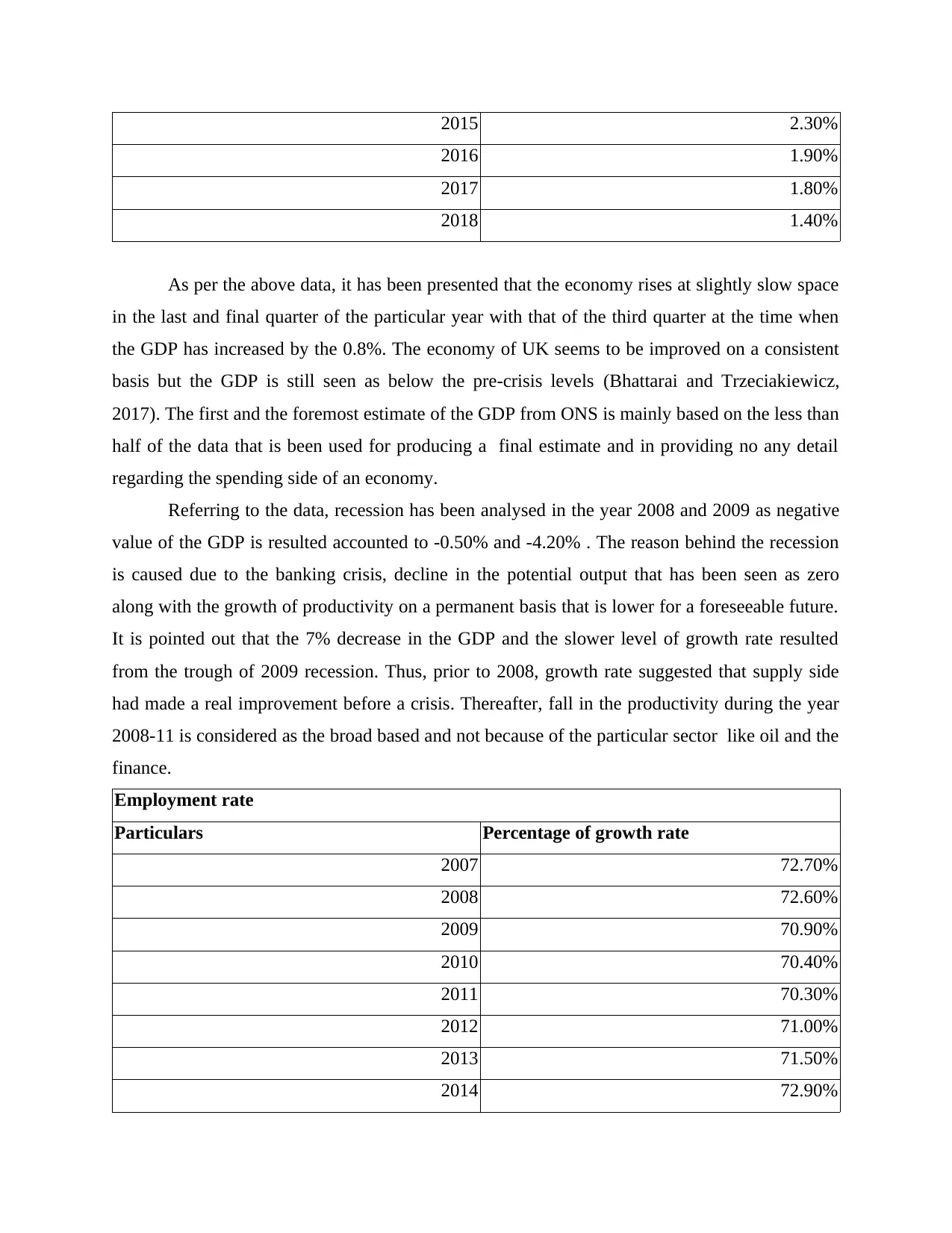
2015 2.30%
2016 1.90%
2017 1.80%
2018 1.40%
As per the above data, it has been presented that the economy rises at slightly slow space
in the last and final quarter of the particular year with that of the third quarter at the time when
the GDP has increased by the 0.8%. The economy of UK seems to be improved on a consistent
basis but the GDP is still seen as below the pre-crisis levels (Bhattarai and Trzeciakiewicz,
2017). The first and the foremost estimate of the GDP from ONS is mainly based on the less than
half of the data that is been used for producing a final estimate and in providing no any detail
regarding the spending side of an economy.
Referring to the data, recession has been analysed in the year 2008 and 2009 as negative
value of the GDP is resulted accounted to -0.50% and -4.20% . The reason behind the recession
is caused due to the banking crisis, decline in the potential output that has been seen as zero
along with the growth of productivity on a permanent basis that is lower for a foreseeable future.
It is pointed out that the 7% decrease in the GDP and the slower level of growth rate resulted
from the trough of 2009 recession. Thus, prior to 2008, growth rate suggested that supply side
had made a real improvement before a crisis. Thereafter, fall in the productivity during the year
2008-11 is considered as the broad based and not because of the particular sector like oil and the
finance.
Employment rate
Particulars Percentage of growth rate
2007 72.70%
2008 72.60%
2009 70.90%
2010 70.40%
2011 70.30%
2012 71.00%
2013 71.50%
2014 72.90%
2016 1.90%
2017 1.80%
2018 1.40%
As per the above data, it has been presented that the economy rises at slightly slow space
in the last and final quarter of the particular year with that of the third quarter at the time when
the GDP has increased by the 0.8%. The economy of UK seems to be improved on a consistent
basis but the GDP is still seen as below the pre-crisis levels (Bhattarai and Trzeciakiewicz,
2017). The first and the foremost estimate of the GDP from ONS is mainly based on the less than
half of the data that is been used for producing a final estimate and in providing no any detail
regarding the spending side of an economy.
Referring to the data, recession has been analysed in the year 2008 and 2009 as negative
value of the GDP is resulted accounted to -0.50% and -4.20% . The reason behind the recession
is caused due to the banking crisis, decline in the potential output that has been seen as zero
along with the growth of productivity on a permanent basis that is lower for a foreseeable future.
It is pointed out that the 7% decrease in the GDP and the slower level of growth rate resulted
from the trough of 2009 recession. Thus, prior to 2008, growth rate suggested that supply side
had made a real improvement before a crisis. Thereafter, fall in the productivity during the year
2008-11 is considered as the broad based and not because of the particular sector like oil and the
finance.
Employment rate
Particulars Percentage of growth rate
2007 72.70%
2008 72.60%
2009 70.90%
2010 70.40%
2011 70.30%
2012 71.00%
2013 71.50%
2014 72.90%
Secure Best Marks with AI Grader
Need help grading? Try our AI Grader for instant feedback on your assignments.
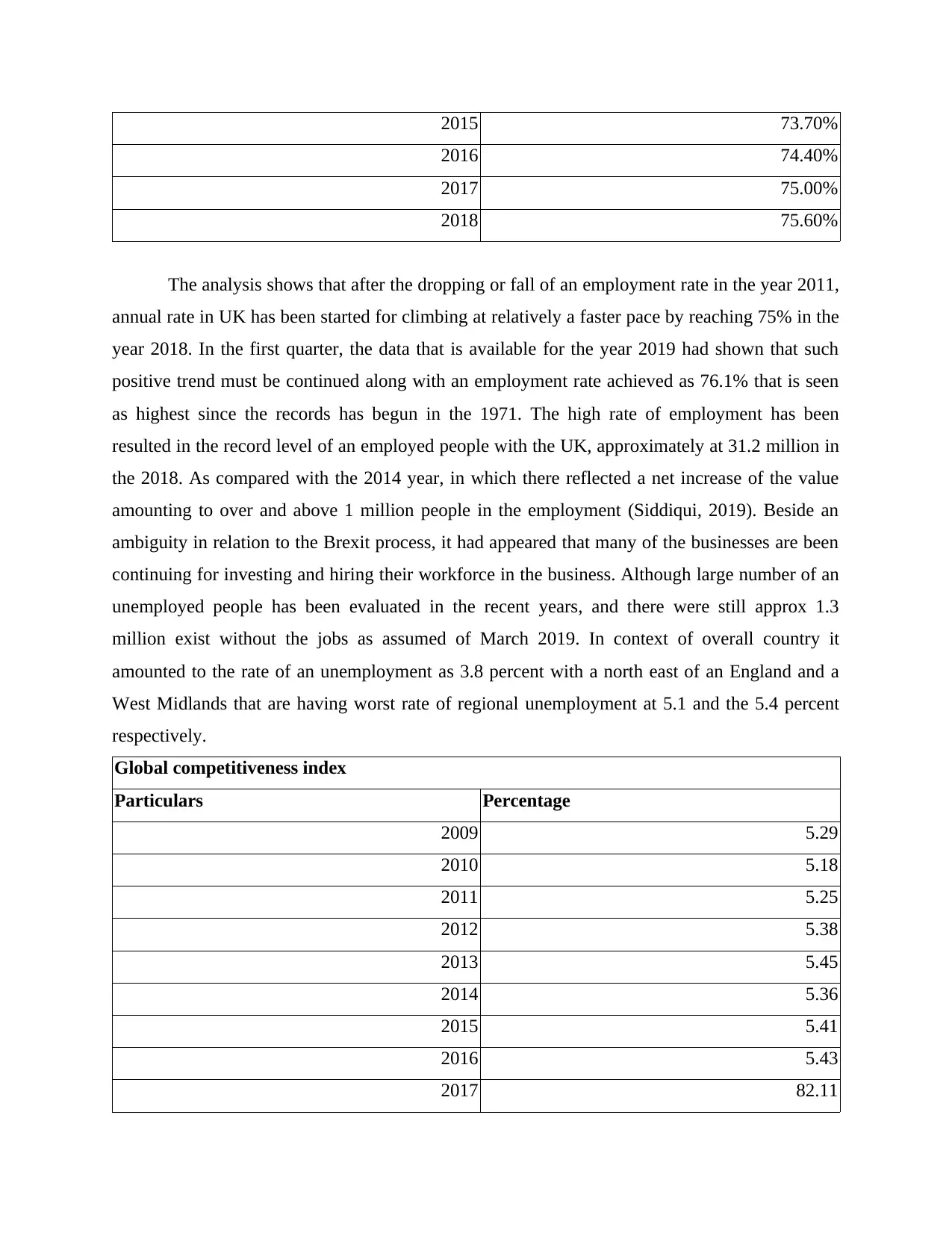
2015 73.70%
2016 74.40%
2017 75.00%
2018 75.60%
The analysis shows that after the dropping or fall of an employment rate in the year 2011,
annual rate in UK has been started for climbing at relatively a faster pace by reaching 75% in the
year 2018. In the first quarter, the data that is available for the year 2019 had shown that such
positive trend must be continued along with an employment rate achieved as 76.1% that is seen
as highest since the records has begun in the 1971. The high rate of employment has been
resulted in the record level of an employed people with the UK, approximately at 31.2 million in
the 2018. As compared with the 2014 year, in which there reflected a net increase of the value
amounting to over and above 1 million people in the employment (Siddiqui, 2019). Beside an
ambiguity in relation to the Brexit process, it had appeared that many of the businesses are been
continuing for investing and hiring their workforce in the business. Although large number of an
unemployed people has been evaluated in the recent years, and there were still approx 1.3
million exist without the jobs as assumed of March 2019. In context of overall country it
amounted to the rate of an unemployment as 3.8 percent with a north east of an England and a
West Midlands that are having worst rate of regional unemployment at 5.1 and the 5.4 percent
respectively.
Global competitiveness index
Particulars Percentage
2009 5.29
2010 5.18
2011 5.25
2012 5.38
2013 5.45
2014 5.36
2015 5.41
2016 5.43
2017 82.11
2016 74.40%
2017 75.00%
2018 75.60%
The analysis shows that after the dropping or fall of an employment rate in the year 2011,
annual rate in UK has been started for climbing at relatively a faster pace by reaching 75% in the
year 2018. In the first quarter, the data that is available for the year 2019 had shown that such
positive trend must be continued along with an employment rate achieved as 76.1% that is seen
as highest since the records has begun in the 1971. The high rate of employment has been
resulted in the record level of an employed people with the UK, approximately at 31.2 million in
the 2018. As compared with the 2014 year, in which there reflected a net increase of the value
amounting to over and above 1 million people in the employment (Siddiqui, 2019). Beside an
ambiguity in relation to the Brexit process, it had appeared that many of the businesses are been
continuing for investing and hiring their workforce in the business. Although large number of an
unemployed people has been evaluated in the recent years, and there were still approx 1.3
million exist without the jobs as assumed of March 2019. In context of overall country it
amounted to the rate of an unemployment as 3.8 percent with a north east of an England and a
West Midlands that are having worst rate of regional unemployment at 5.1 and the 5.4 percent
respectively.
Global competitiveness index
Particulars Percentage
2009 5.29
2010 5.18
2011 5.25
2012 5.38
2013 5.45
2014 5.36
2015 5.41
2016 5.43
2017 82.11

2018 81.99
In the year 2018, UK economy seems as likely to exhibit the growth above the trend
economic growth rate and lies in mature phase of the business cycle in respect of an economic
expansion which have started in the year 2009 by following of the recession. The economy of the
UK had indicated that it could perform in a way that expects for an advanced mature level of
economy. It had weathered a great recession in a well reasonable manner. It contains a flexible
and the labour market which adjusts efficiently in changing the circumstances and the labour
market which had performed very well in consideration to both at the time of falling an output
and in respect to subsequent recovery (Matelly and Lima, 2016). Furthermore, an extent of the
capacity in absorbing the change that had been illustrated in a way which had a significant
contraction in the employment of public sector which had been more as offsetting by the
expansion of an employment in private sector. Unemployment had declined and an employment
rate has steadily expanded to an extent of approaching to full employment. Furthermore, there
present an effect on the employment arising from an execution of National Living Wage that
likely to be constrain the growth of an employment relating to lower level of the skills.
b. Assessing market structure of an industry within which the organization operates its business
functions.
Performance analysis of Rolls-Royce
Particulars 2015 2016 2017 2018
Gross profit
margin 23.8 20.4 19.5 7.6
Net profit margin 0.6 -26.96 25.8 -15.26
Return on equity 1.46 -117.28 104.8 -94.29
Asset turnover 0.62 0.62 0.59 0.51
Inventory turnover 3.87 4.16 3.89 3.66
Interpretation- Gross profit margin reveals the amount of profits generated by the
company after meeting its cost associated with the sales. Higher the ratio, better is the
In the year 2018, UK economy seems as likely to exhibit the growth above the trend
economic growth rate and lies in mature phase of the business cycle in respect of an economic
expansion which have started in the year 2009 by following of the recession. The economy of the
UK had indicated that it could perform in a way that expects for an advanced mature level of
economy. It had weathered a great recession in a well reasonable manner. It contains a flexible
and the labour market which adjusts efficiently in changing the circumstances and the labour
market which had performed very well in consideration to both at the time of falling an output
and in respect to subsequent recovery (Matelly and Lima, 2016). Furthermore, an extent of the
capacity in absorbing the change that had been illustrated in a way which had a significant
contraction in the employment of public sector which had been more as offsetting by the
expansion of an employment in private sector. Unemployment had declined and an employment
rate has steadily expanded to an extent of approaching to full employment. Furthermore, there
present an effect on the employment arising from an execution of National Living Wage that
likely to be constrain the growth of an employment relating to lower level of the skills.
b. Assessing market structure of an industry within which the organization operates its business
functions.
Performance analysis of Rolls-Royce
Particulars 2015 2016 2017 2018
Gross profit
margin 23.8 20.4 19.5 7.6
Net profit margin 0.6 -26.96 25.8 -15.26
Return on equity 1.46 -117.28 104.8 -94.29
Asset turnover 0.62 0.62 0.59 0.51
Inventory turnover 3.87 4.16 3.89 3.66
Interpretation- Gross profit margin reveals the amount of profits generated by the
company after meeting its cost associated with the sales. Higher the ratio, better is the

performance of the company. The above results depicts that over the years gross profit margin of
Rolls-Royce is declining which means that company is incapable of making payment of its
variable cost against its revenues. This in turn shows that financial performance of the company
is becoming poor with passage of years as it is not keeping control over its spending as its ratio is
declining. Return on equity and net profit ratio of the company is also declining and resulting as
negative which reflects that company is bearing losses and does not have sufficient amount to
pay-off its expenses, taxes and the costs. Efficiency ratio measures the company’s ability in
using its assets to generate income. The efficiency ratios of the company also shows a declining
trend which indicates that the firm is not making effective and efficient use of its assets and
inventory in generating larger profits.
Porter’s five forces analysis
Threat relating to new entrant- New firms in the industrial goods and the services
brings for an innovation, new methods in doing the things results to higher level of the pressure
on the Rolls-Royce Plc through the lower through the strategy of lower pricing, reducing the cost
and in facilitating the new value propositions towards the customers. Rolls-Royce has to manage
for all such challenges and in building effective barriers in order to safeguard a competitive edge
against rivalry.
Bargaining power of the supplier- As all companies in industrial services and the goods
purchases the raw material from several suppliers (Rolls-Royce Holdings Plc Porter Five Forces
Analysis, 2019). The suppliers that are present in the dominant position could decrease margins
of Rolls Royce within the market. Suppliers who are powerful in the industry sector use their
respective negotiating power in extracting the higher prices from an enterprise in the Industrial
services and the goods. The entire effect of higher supplier power lowers the profitability of an
industrial service and the goods.
Bargaining power of the buyer- Rolls Royce faces strong buyer power as they desires
fro buying a best offering that is available by making payment of the minimum price. This in
turn puts high pressure on the profitability of Rolls-Royce in long term. The more powerful and
the stronger customer base of the company, higher is the bargaining power of buyer and higher is
their ability in seeking for increased offers and the discounts.
Rolls-Royce is declining which means that company is incapable of making payment of its
variable cost against its revenues. This in turn shows that financial performance of the company
is becoming poor with passage of years as it is not keeping control over its spending as its ratio is
declining. Return on equity and net profit ratio of the company is also declining and resulting as
negative which reflects that company is bearing losses and does not have sufficient amount to
pay-off its expenses, taxes and the costs. Efficiency ratio measures the company’s ability in
using its assets to generate income. The efficiency ratios of the company also shows a declining
trend which indicates that the firm is not making effective and efficient use of its assets and
inventory in generating larger profits.
Porter’s five forces analysis
Threat relating to new entrant- New firms in the industrial goods and the services
brings for an innovation, new methods in doing the things results to higher level of the pressure
on the Rolls-Royce Plc through the lower through the strategy of lower pricing, reducing the cost
and in facilitating the new value propositions towards the customers. Rolls-Royce has to manage
for all such challenges and in building effective barriers in order to safeguard a competitive edge
against rivalry.
Bargaining power of the supplier- As all companies in industrial services and the goods
purchases the raw material from several suppliers (Rolls-Royce Holdings Plc Porter Five Forces
Analysis, 2019). The suppliers that are present in the dominant position could decrease margins
of Rolls Royce within the market. Suppliers who are powerful in the industry sector use their
respective negotiating power in extracting the higher prices from an enterprise in the Industrial
services and the goods. The entire effect of higher supplier power lowers the profitability of an
industrial service and the goods.
Bargaining power of the buyer- Rolls Royce faces strong buyer power as they desires
fro buying a best offering that is available by making payment of the minimum price. This in
turn puts high pressure on the profitability of Rolls-Royce in long term. The more powerful and
the stronger customer base of the company, higher is the bargaining power of buyer and higher is
their ability in seeking for increased offers and the discounts.
Paraphrase This Document
Need a fresh take? Get an instant paraphrase of this document with our AI Paraphraser
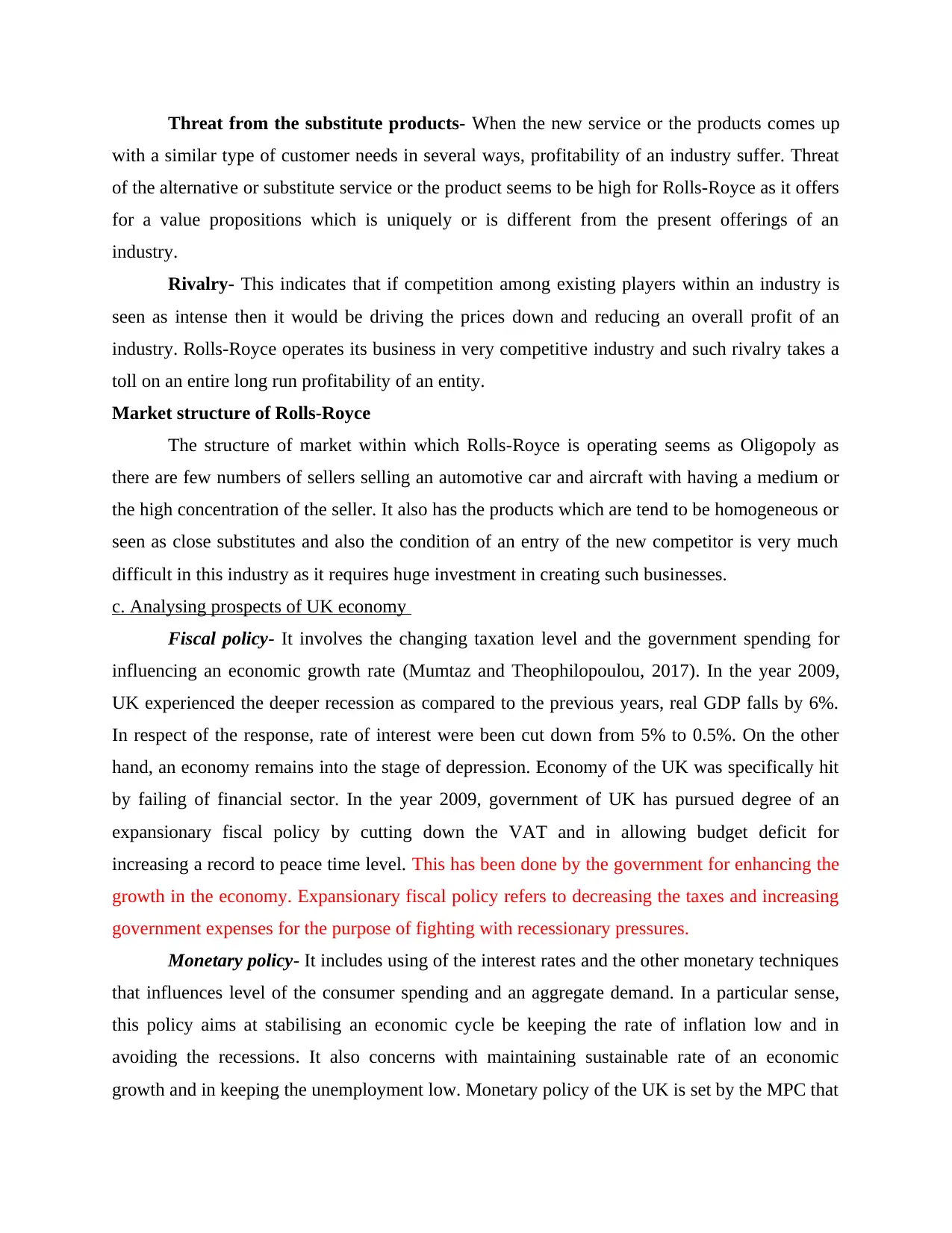
Threat from the substitute products- When the new service or the products comes up
with a similar type of customer needs in several ways, profitability of an industry suffer. Threat
of the alternative or substitute service or the product seems to be high for Rolls-Royce as it offers
for a value propositions which is uniquely or is different from the present offerings of an
industry.
Rivalry- This indicates that if competition among existing players within an industry is
seen as intense then it would be driving the prices down and reducing an overall profit of an
industry. Rolls-Royce operates its business in very competitive industry and such rivalry takes a
toll on an entire long run profitability of an entity.
Market structure of Rolls-Royce
The structure of market within which Rolls-Royce is operating seems as Oligopoly as
there are few numbers of sellers selling an automotive car and aircraft with having a medium or
the high concentration of the seller. It also has the products which are tend to be homogeneous or
seen as close substitutes and also the condition of an entry of the new competitor is very much
difficult in this industry as it requires huge investment in creating such businesses.
c. Analysing prospects of UK economy
Fiscal policy- It involves the changing taxation level and the government spending for
influencing an economic growth rate (Mumtaz and Theophilopoulou, 2017). In the year 2009,
UK experienced the deeper recession as compared to the previous years, real GDP falls by 6%.
In respect of the response, rate of interest were been cut down from 5% to 0.5%. On the other
hand, an economy remains into the stage of depression. Economy of the UK was specifically hit
by failing of financial sector. In the year 2009, government of UK has pursued degree of an
expansionary fiscal policy by cutting down the VAT and in allowing budget deficit for
increasing a record to peace time level. This has been done by the government for enhancing the
growth in the economy. Expansionary fiscal policy refers to decreasing the taxes and increasing
government expenses for the purpose of fighting with recessionary pressures.
Monetary policy- It includes using of the interest rates and the other monetary techniques
that influences level of the consumer spending and an aggregate demand. In a particular sense,
this policy aims at stabilising an economic cycle be keeping the rate of inflation low and in
avoiding the recessions. It also concerns with maintaining sustainable rate of an economic
growth and in keeping the unemployment low. Monetary policy of the UK is set by the MPC that
with a similar type of customer needs in several ways, profitability of an industry suffer. Threat
of the alternative or substitute service or the product seems to be high for Rolls-Royce as it offers
for a value propositions which is uniquely or is different from the present offerings of an
industry.
Rivalry- This indicates that if competition among existing players within an industry is
seen as intense then it would be driving the prices down and reducing an overall profit of an
industry. Rolls-Royce operates its business in very competitive industry and such rivalry takes a
toll on an entire long run profitability of an entity.
Market structure of Rolls-Royce
The structure of market within which Rolls-Royce is operating seems as Oligopoly as
there are few numbers of sellers selling an automotive car and aircraft with having a medium or
the high concentration of the seller. It also has the products which are tend to be homogeneous or
seen as close substitutes and also the condition of an entry of the new competitor is very much
difficult in this industry as it requires huge investment in creating such businesses.
c. Analysing prospects of UK economy
Fiscal policy- It involves the changing taxation level and the government spending for
influencing an economic growth rate (Mumtaz and Theophilopoulou, 2017). In the year 2009,
UK experienced the deeper recession as compared to the previous years, real GDP falls by 6%.
In respect of the response, rate of interest were been cut down from 5% to 0.5%. On the other
hand, an economy remains into the stage of depression. Economy of the UK was specifically hit
by failing of financial sector. In the year 2009, government of UK has pursued degree of an
expansionary fiscal policy by cutting down the VAT and in allowing budget deficit for
increasing a record to peace time level. This has been done by the government for enhancing the
growth in the economy. Expansionary fiscal policy refers to decreasing the taxes and increasing
government expenses for the purpose of fighting with recessionary pressures.
Monetary policy- It includes using of the interest rates and the other monetary techniques
that influences level of the consumer spending and an aggregate demand. In a particular sense,
this policy aims at stabilising an economic cycle be keeping the rate of inflation low and in
avoiding the recessions. It also concerns with maintaining sustainable rate of an economic
growth and in keeping the unemployment low. Monetary policy of the UK is set by the MPC that
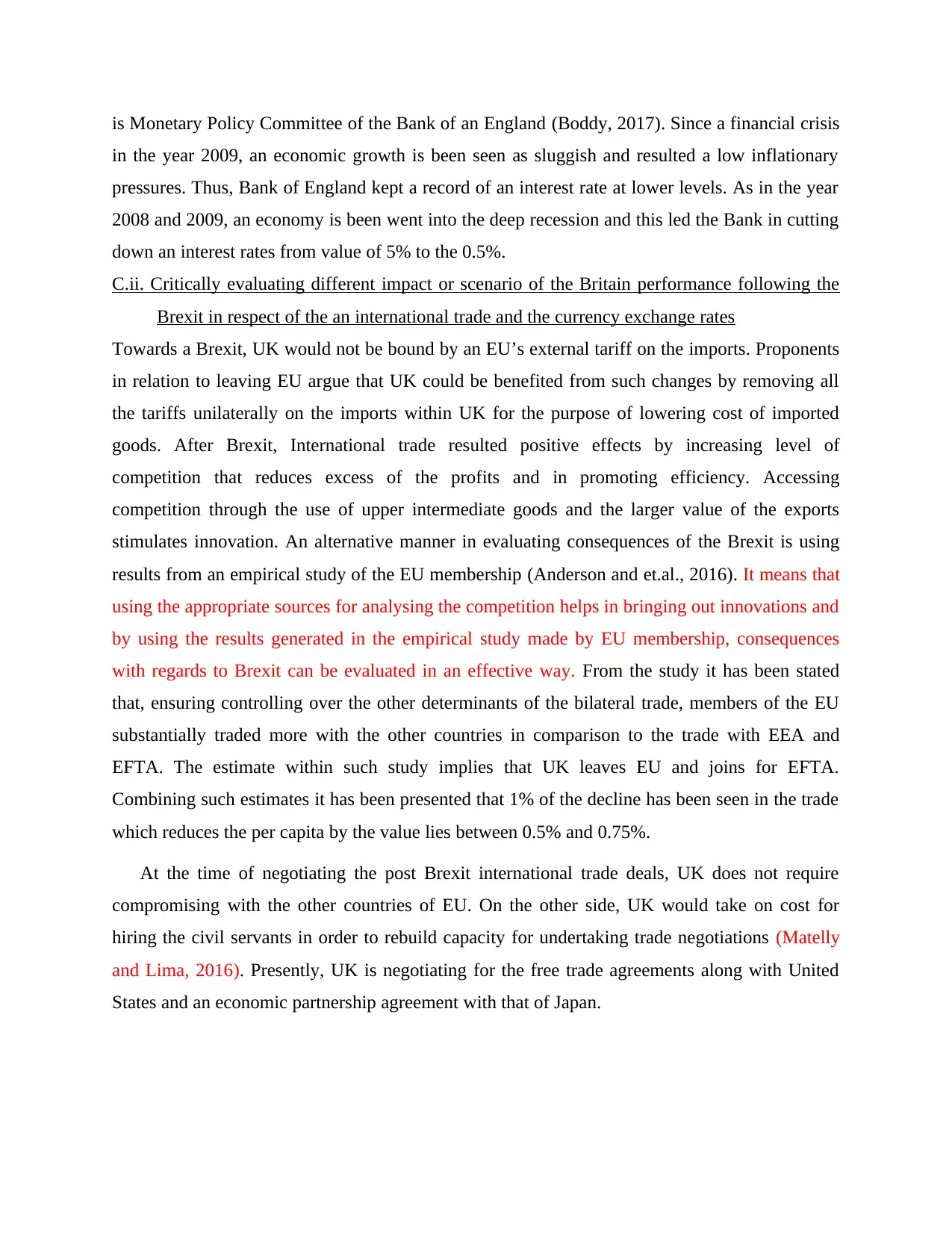
is Monetary Policy Committee of the Bank of an England (Boddy, 2017). Since a financial crisis
in the year 2009, an economic growth is been seen as sluggish and resulted a low inflationary
pressures. Thus, Bank of England kept a record of an interest rate at lower levels. As in the year
2008 and 2009, an economy is been went into the deep recession and this led the Bank in cutting
down an interest rates from value of 5% to the 0.5%.
C.ii. Critically evaluating different impact or scenario of the Britain performance following the
Brexit in respect of the an international trade and the currency exchange rates
Towards a Brexit, UK would not be bound by an EU’s external tariff on the imports. Proponents
in relation to leaving EU argue that UK could be benefited from such changes by removing all
the tariffs unilaterally on the imports within UK for the purpose of lowering cost of imported
goods. After Brexit, International trade resulted positive effects by increasing level of
competition that reduces excess of the profits and in promoting efficiency. Accessing
competition through the use of upper intermediate goods and the larger value of the exports
stimulates innovation. An alternative manner in evaluating consequences of the Brexit is using
results from an empirical study of the EU membership (Anderson and et.al., 2016). It means that
using the appropriate sources for analysing the competition helps in bringing out innovations and
by using the results generated in the empirical study made by EU membership, consequences
with regards to Brexit can be evaluated in an effective way. From the study it has been stated
that, ensuring controlling over the other determinants of the bilateral trade, members of the EU
substantially traded more with the other countries in comparison to the trade with EEA and
EFTA. The estimate within such study implies that UK leaves EU and joins for EFTA.
Combining such estimates it has been presented that 1% of the decline has been seen in the trade
which reduces the per capita by the value lies between 0.5% and 0.75%.
At the time of negotiating the post Brexit international trade deals, UK does not require
compromising with the other countries of EU. On the other side, UK would take on cost for
hiring the civil servants in order to rebuild capacity for undertaking trade negotiations (Matelly
and Lima, 2016). Presently, UK is negotiating for the free trade agreements along with United
States and an economic partnership agreement with that of Japan.
in the year 2009, an economic growth is been seen as sluggish and resulted a low inflationary
pressures. Thus, Bank of England kept a record of an interest rate at lower levels. As in the year
2008 and 2009, an economy is been went into the deep recession and this led the Bank in cutting
down an interest rates from value of 5% to the 0.5%.
C.ii. Critically evaluating different impact or scenario of the Britain performance following the
Brexit in respect of the an international trade and the currency exchange rates
Towards a Brexit, UK would not be bound by an EU’s external tariff on the imports. Proponents
in relation to leaving EU argue that UK could be benefited from such changes by removing all
the tariffs unilaterally on the imports within UK for the purpose of lowering cost of imported
goods. After Brexit, International trade resulted positive effects by increasing level of
competition that reduces excess of the profits and in promoting efficiency. Accessing
competition through the use of upper intermediate goods and the larger value of the exports
stimulates innovation. An alternative manner in evaluating consequences of the Brexit is using
results from an empirical study of the EU membership (Anderson and et.al., 2016). It means that
using the appropriate sources for analysing the competition helps in bringing out innovations and
by using the results generated in the empirical study made by EU membership, consequences
with regards to Brexit can be evaluated in an effective way. From the study it has been stated
that, ensuring controlling over the other determinants of the bilateral trade, members of the EU
substantially traded more with the other countries in comparison to the trade with EEA and
EFTA. The estimate within such study implies that UK leaves EU and joins for EFTA.
Combining such estimates it has been presented that 1% of the decline has been seen in the trade
which reduces the per capita by the value lies between 0.5% and 0.75%.
At the time of negotiating the post Brexit international trade deals, UK does not require
compromising with the other countries of EU. On the other side, UK would take on cost for
hiring the civil servants in order to rebuild capacity for undertaking trade negotiations (Matelly
and Lima, 2016). Presently, UK is negotiating for the free trade agreements along with United
States and an economic partnership agreement with that of Japan.
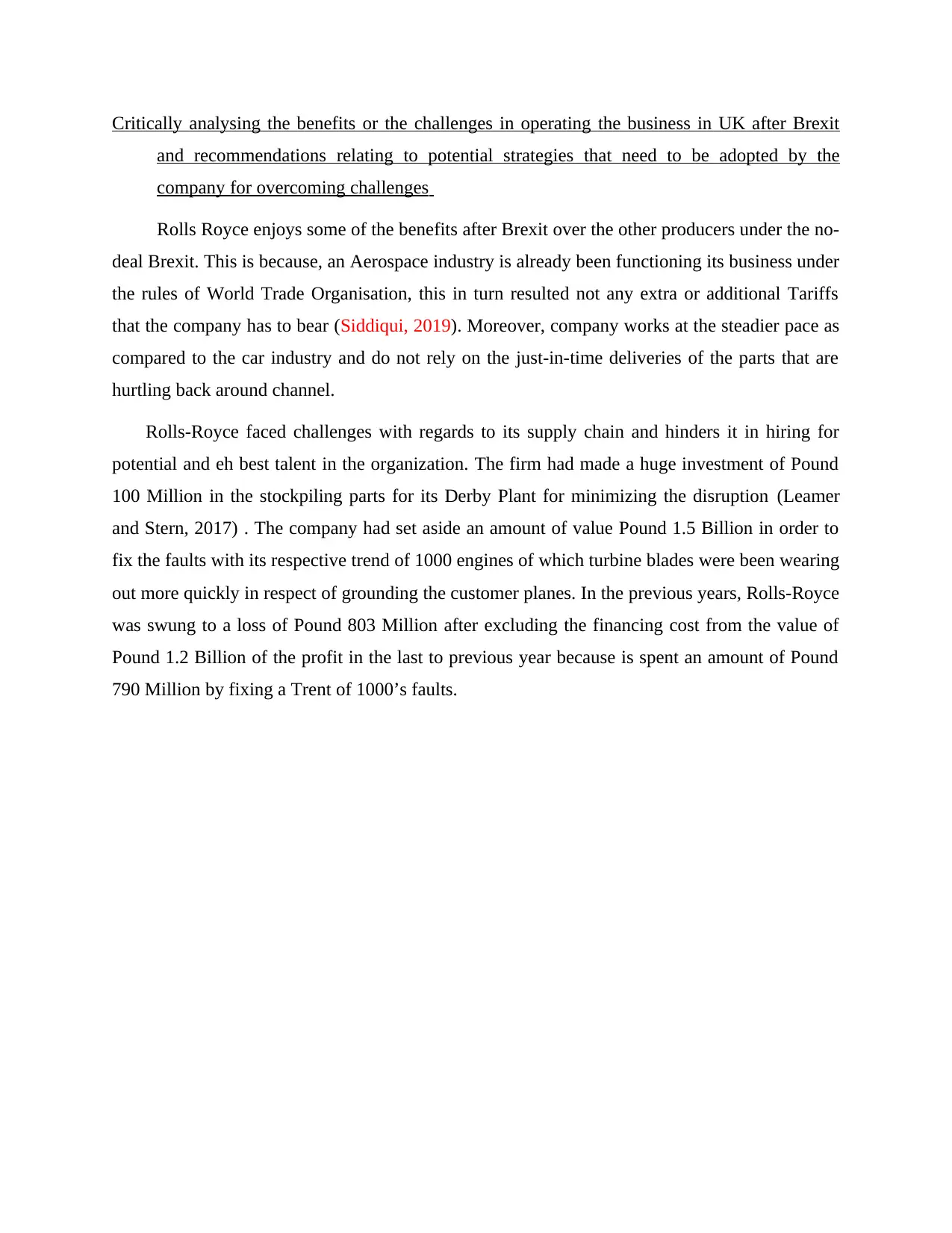
Critically analysing the benefits or the challenges in operating the business in UK after Brexit
and recommendations relating to potential strategies that need to be adopted by the
company for overcoming challenges
Rolls Royce enjoys some of the benefits after Brexit over the other producers under the no-
deal Brexit. This is because, an Aerospace industry is already been functioning its business under
the rules of World Trade Organisation, this in turn resulted not any extra or additional Tariffs
that the company has to bear (Siddiqui, 2019). Moreover, company works at the steadier pace as
compared to the car industry and do not rely on the just-in-time deliveries of the parts that are
hurtling back around channel.
Rolls-Royce faced challenges with regards to its supply chain and hinders it in hiring for
potential and eh best talent in the organization. The firm had made a huge investment of Pound
100 Million in the stockpiling parts for its Derby Plant for minimizing the disruption (Leamer
and Stern, 2017) . The company had set aside an amount of value Pound 1.5 Billion in order to
fix the faults with its respective trend of 1000 engines of which turbine blades were been wearing
out more quickly in respect of grounding the customer planes. In the previous years, Rolls-Royce
was swung to a loss of Pound 803 Million after excluding the financing cost from the value of
Pound 1.2 Billion of the profit in the last to previous year because is spent an amount of Pound
790 Million by fixing a Trent of 1000’s faults.
and recommendations relating to potential strategies that need to be adopted by the
company for overcoming challenges
Rolls Royce enjoys some of the benefits after Brexit over the other producers under the no-
deal Brexit. This is because, an Aerospace industry is already been functioning its business under
the rules of World Trade Organisation, this in turn resulted not any extra or additional Tariffs
that the company has to bear (Siddiqui, 2019). Moreover, company works at the steadier pace as
compared to the car industry and do not rely on the just-in-time deliveries of the parts that are
hurtling back around channel.
Rolls-Royce faced challenges with regards to its supply chain and hinders it in hiring for
potential and eh best talent in the organization. The firm had made a huge investment of Pound
100 Million in the stockpiling parts for its Derby Plant for minimizing the disruption (Leamer
and Stern, 2017) . The company had set aside an amount of value Pound 1.5 Billion in order to
fix the faults with its respective trend of 1000 engines of which turbine blades were been wearing
out more quickly in respect of grounding the customer planes. In the previous years, Rolls-Royce
was swung to a loss of Pound 803 Million after excluding the financing cost from the value of
Pound 1.2 Billion of the profit in the last to previous year because is spent an amount of Pound
790 Million by fixing a Trent of 1000’s faults.
Secure Best Marks with AI Grader
Need help grading? Try our AI Grader for instant feedback on your assignments.
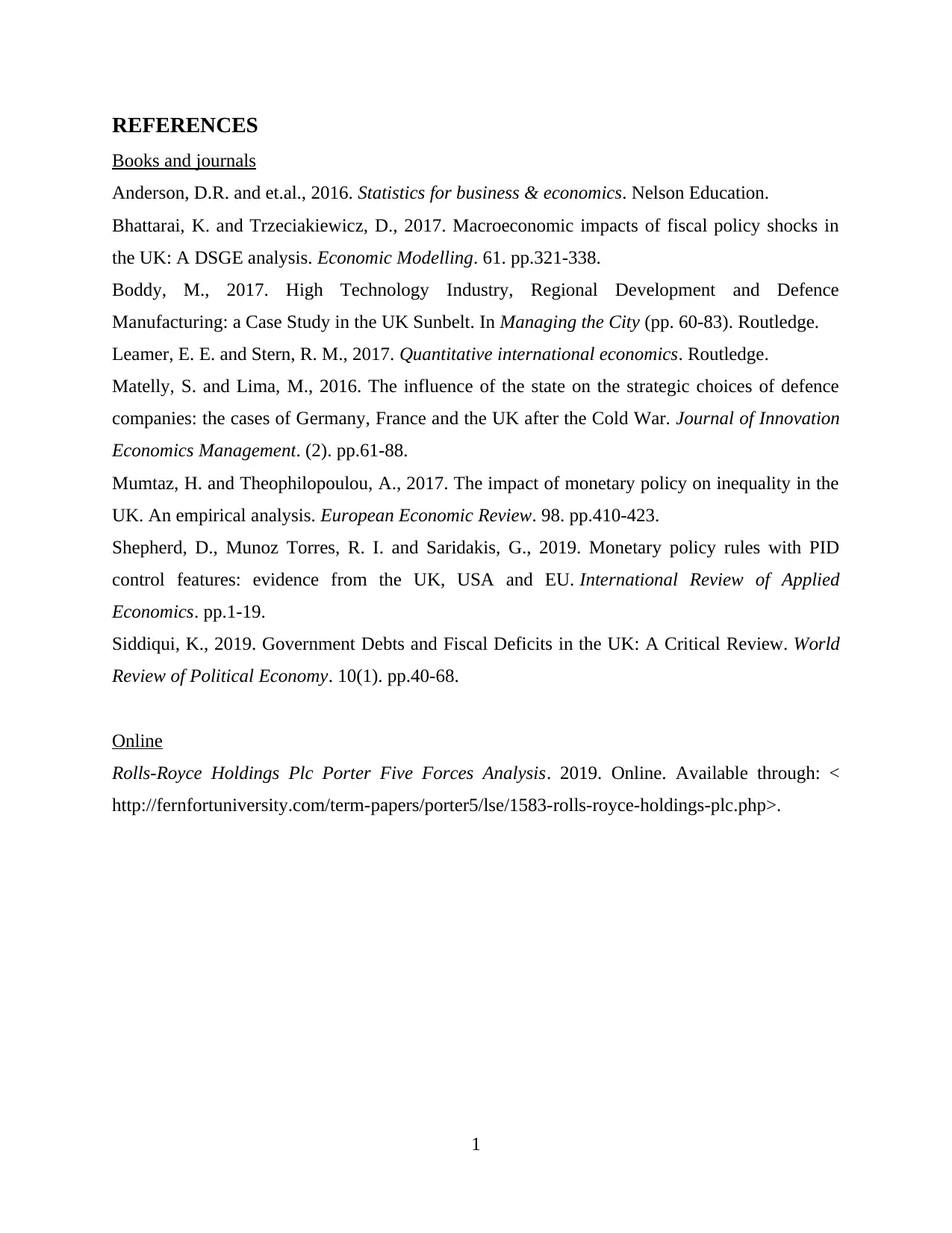
REFERENCES
Books and journals
Anderson, D.R. and et.al., 2016. Statistics for business & economics. Nelson Education.
Bhattarai, K. and Trzeciakiewicz, D., 2017. Macroeconomic impacts of fiscal policy shocks in
the UK: A DSGE analysis. Economic Modelling. 61. pp.321-338.
Boddy, M., 2017. High Technology Industry, Regional Development and Defence
Manufacturing: a Case Study in the UK Sunbelt. In Managing the City (pp. 60-83). Routledge.
Leamer, E. E. and Stern, R. M., 2017. Quantitative international economics. Routledge.
Matelly, S. and Lima, M., 2016. The influence of the state on the strategic choices of defence
companies: the cases of Germany, France and the UK after the Cold War. Journal of Innovation
Economics Management. (2). pp.61-88.
Mumtaz, H. and Theophilopoulou, A., 2017. The impact of monetary policy on inequality in the
UK. An empirical analysis. European Economic Review. 98. pp.410-423.
Shepherd, D., Munoz Torres, R. I. and Saridakis, G., 2019. Monetary policy rules with PID
control features: evidence from the UK, USA and EU. International Review of Applied
Economics. pp.1-19.
Siddiqui, K., 2019. Government Debts and Fiscal Deficits in the UK: A Critical Review. World
Review of Political Economy. 10(1). pp.40-68.
Online
Rolls-Royce Holdings Plc Porter Five Forces Analysis. 2019. Online. Available through: <
http://fernfortuniversity.com/term-papers/porter5/lse/1583-rolls-royce-holdings-plc.php>.
1
Books and journals
Anderson, D.R. and et.al., 2016. Statistics for business & economics. Nelson Education.
Bhattarai, K. and Trzeciakiewicz, D., 2017. Macroeconomic impacts of fiscal policy shocks in
the UK: A DSGE analysis. Economic Modelling. 61. pp.321-338.
Boddy, M., 2017. High Technology Industry, Regional Development and Defence
Manufacturing: a Case Study in the UK Sunbelt. In Managing the City (pp. 60-83). Routledge.
Leamer, E. E. and Stern, R. M., 2017. Quantitative international economics. Routledge.
Matelly, S. and Lima, M., 2016. The influence of the state on the strategic choices of defence
companies: the cases of Germany, France and the UK after the Cold War. Journal of Innovation
Economics Management. (2). pp.61-88.
Mumtaz, H. and Theophilopoulou, A., 2017. The impact of monetary policy on inequality in the
UK. An empirical analysis. European Economic Review. 98. pp.410-423.
Shepherd, D., Munoz Torres, R. I. and Saridakis, G., 2019. Monetary policy rules with PID
control features: evidence from the UK, USA and EU. International Review of Applied
Economics. pp.1-19.
Siddiqui, K., 2019. Government Debts and Fiscal Deficits in the UK: A Critical Review. World
Review of Political Economy. 10(1). pp.40-68.
Online
Rolls-Royce Holdings Plc Porter Five Forces Analysis. 2019. Online. Available through: <
http://fernfortuniversity.com/term-papers/porter5/lse/1583-rolls-royce-holdings-plc.php>.
1

2
1 out of 12
Related Documents
Your All-in-One AI-Powered Toolkit for Academic Success.
+13062052269
info@desklib.com
Available 24*7 on WhatsApp / Email
![[object Object]](/_next/static/media/star-bottom.7253800d.svg)
Unlock your academic potential
© 2024 | Zucol Services PVT LTD | All rights reserved.





